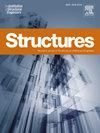在钢筋混凝土结构中,梁可以节省大量的碳
IF 4.3
2区 工程技术
Q1 ENGINEERING, CIVIL
引用次数: 0
摘要
钢筋混凝土结构显著增加了建筑物的碳含量,地板设计优化对于材料效率和结构脱碳至关重要。本研究评估了巴西一座假设的四层建筑的七个现浇钢筋混凝土楼板系统的隐含碳、材料使用、成本和劳动强度,考虑了四个不同的柱跨度。楼板系统之间的主要区别是所使用的梁的数量。结果表明,28种替代方案的隐含碳强度差异为3.4倍,范围为48至167 kg CO2/m2。梁式楼板的材料强度和碳含量较低,而平板楼板的性能较差,特别是对于大跨度的后张拉要求。尽管模板复杂性更高,但由于节省材料,具有更多梁的地板系统仍然具有成本竞争力,这表明低碳和低成本设计可以共存。这项研究鼓励结构设计师优先考虑材料高效的解决方案来脱碳钢筋混凝土结构。它表明,目前的技术可以实现大量的节约,提供了切实可行的方法来减少建筑对环境的影响,同时确保经济可行性。本文章由计算机程序翻译,如有差异,请以英文原文为准。
Beams unlock large carbon savings in reinforced concrete structures
Reinforced concrete structures significantly contribute to buildings’ embodied carbon, with floor design optimisation being crucial for material efficiency and structural decarbonisation. This study evaluates the embodied carbon, material use, cost, and labour intensity of seven cast-in-place reinforced concrete floor systems for a hypothetical four-story building in Brazil, considering four different column spans. The primary difference among the floor systems is the number of beams used. Results show a 3.4-fold variation in the embodied carbon intensity among the 28 alternatives, ranging from 48 to 167 kg CO2/m2. Beam-supported floors have lower material intensity and embodied carbon, while flat slabs perform worse, especially for larger spans due to post-tensioning requirements. Despite higher formwork complexity, floor systems with more beams remain cost-competitive due to material savings, demonstrating that low-carbon and low-cost designs can coexist. This study encourages structural designers to prioritise material-efficient solutions for decarbonising reinforced concrete structures. It shows that substantial savings can be achieved with current technology, offering practical ways to reduce buildings’ environmental impact while ensuring economic feasibility.
求助全文
通过发布文献求助,成功后即可免费获取论文全文。
去求助
来源期刊

Structures
Engineering-Architecture
CiteScore
5.70
自引率
17.10%
发文量
1187
期刊介绍:
Structures aims to publish internationally-leading research across the full breadth of structural engineering. Papers for Structures are particularly welcome in which high-quality research will benefit from wide readership of academics and practitioners such that not only high citation rates but also tangible industrial-related pathways to impact are achieved.
 求助内容:
求助内容: 应助结果提醒方式:
应助结果提醒方式:


